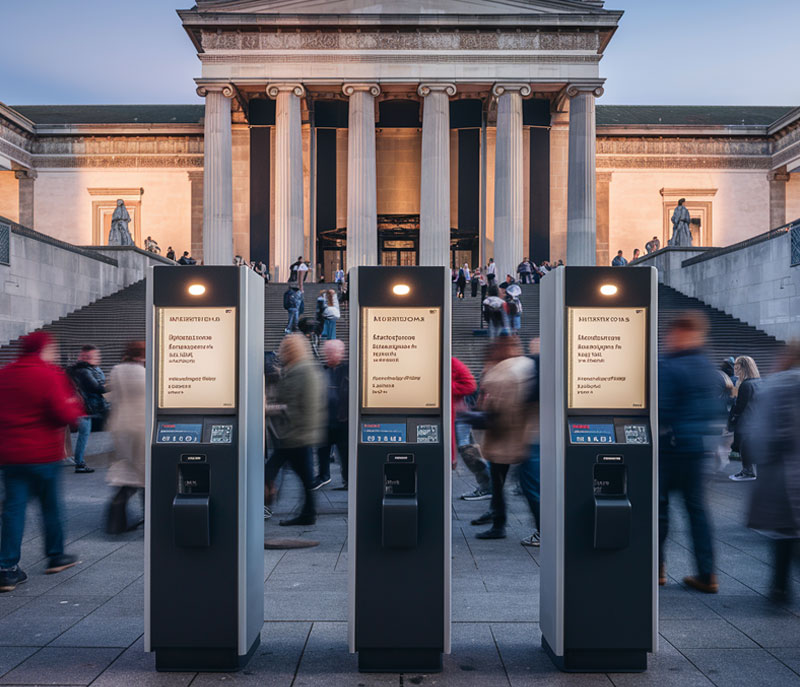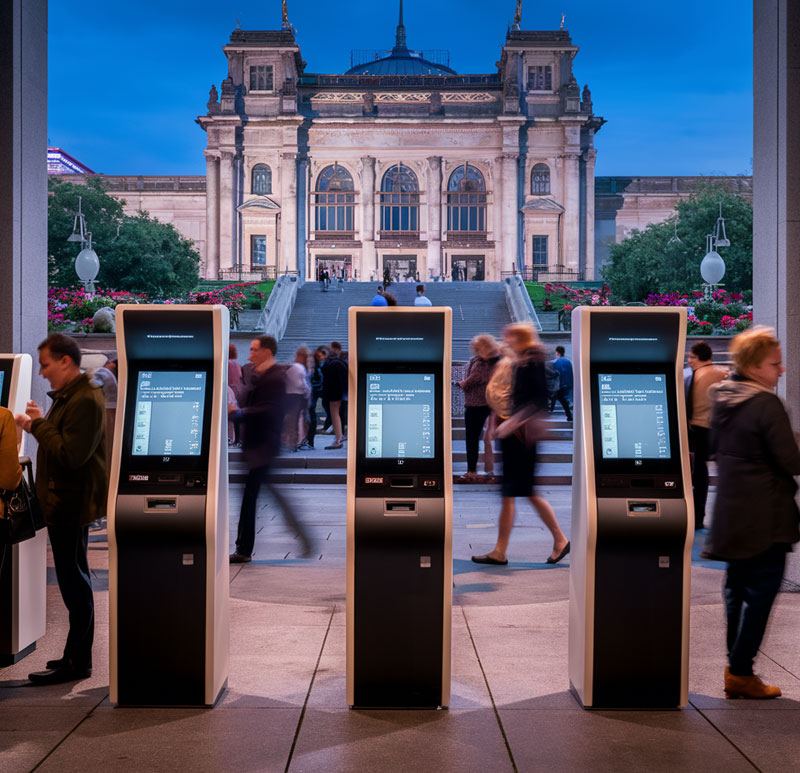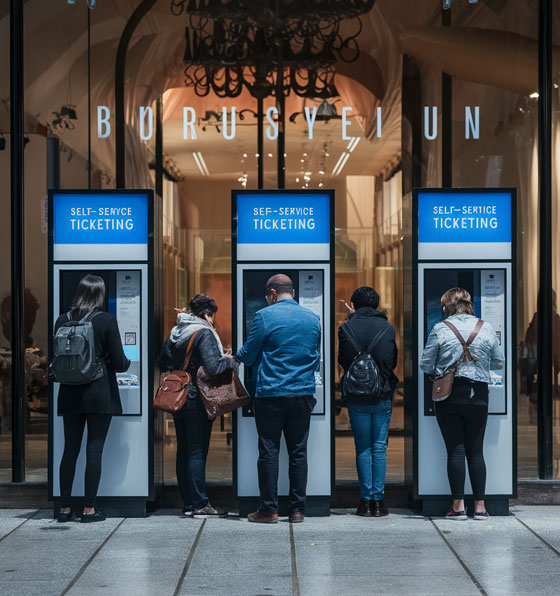Self-Service Kiosks in Cultural Institutions and Festivals: Enhancing Visitor Engagement and Experience
Cultural institutions play a pivotal role in society as they perceive, conserve, and disseminate knowledge, values, and information to the public in various ways. Deploying self-service kiosks in cultural institutions such as museums, libraries, festivals, and mosques enhances visitor engagement and experience. Improved visitor experiences lead to enhanced customer engagement. Let us delve into the practicality of creating diverse and engaging visitor experiences in these settings, one by one.
Self-service kiosks for museums
Museums are buildings where objects or artefacts of historic, cultural, or scientific value are stored and displayed. When museums are professionally managed and they feature objects of value, they attract people in large numbers. Museum curators can enhance visitor engagement when the value or importance of the exhibits is properly conveyed to the visitors. A great way to achieve this is by deploying self-service or interactive kiosks. An interactive kiosk can be used for multiple purposes in a museum setting, such as conveying information, museum navigation, managing ticketing, etc. Let’s go through each one of them.


Features of a self-service museum kiosk
Seamless ticketing and entry - Long lines at ticket windows have become a much common sight in today's busy museum scene. The visitors are forced to wait at the counters for several minutes, especially in the peak hours, which ultimately impacts their museum experience. The inclusion of self-service museum kiosks alleviates the discomfort of lengthy line-ups by automating the ticketing procedure and providing customers with a quick and easy way to purchase tickets. Yes, the incorporation of self-service ticketing kiosks has emerged as a revolutionary solution in improving the overall visitor experience.
When visitors approach these intuitive terminals, they are equipped to quickly manage the ticket buying process, hence avoiding the necessity of extended wait times. In a matter of seconds, customers may choose the tickets they want and proceed with payment. This quick transaction maximizes operational efficiency for museum employees while simultaneously improving visitor happiness.
Consequently, visitors are granted additional time to fully engage with the diverse array of displays and events, resulting in an incredibly engaging and unforgettable museum experience for everyone.
Convey useful information - There are multiple ways to enhance the overall museum experience for visitors. And they are listed below.
By integrating an audio functionality into the kiosk machine, the visitors can pick their desired language and listen to the recorded narration of a particular exhibit displayed in the museum.
leveraging the benefits of Augmented Reality (AR) has the potential to enhance visitor experience to the next level. AR can be used to recreate historical events, gain a deep and extensive understanding of the artefacts through immersive learning, access animated video contents etc.
VR in museums is trending right now! Self-service kiosks integrated with VR technology create engaging experiences for visitors by bringing exhibits to life. VR transports visitors to another dimension, location, or time, adding context to an exhibit and allowing them to experience it in its actual scale. Indeed, VR takes storytelling in museums to the next level. Offering virtual tours is another possibility for incorporating VR into museum settings. Virtual tours provide an incredible opportunity for visitors to experience museum exhibits remotely from a different location. Yes, visitors need not physically visit the museum but can experience the wonders from their own location, for example, from another country! Isn’t it brilliant? Virtual Reality also facilitates the 'virtual interaction' experience for visitors, allowing them to feel and inspect artefacts which would otherwise not be possible.

Museum navigation - Interactive kiosks, with the help of maps, can guide or assist visitors in navigating the entire museum with ease. Finding a specific exhibit can be a daunting task in a large museum. Interactive kiosks loaded with detailed maps of the museum can guide visitors to a specific location or exhibit of interest without seeking help from anyone. Interactive kiosks can also educate visitors about approaching events, special offers, new exhibit information, or any specific facilities offered on the premises of the museum, with much precision.
Collect feedback from visitors - Collecting feedback from visitors helps museum authorities gather valuable data pertaining to the quality of the services offered, the value of the exhibits displayed, and analyse any room for improvement. The authorities can also conduct surveys regarding visitor experience or ask visitors to provide a visitor experience rating via the kiosk interface.
Accept donations - Self-service kiosks can also accept donations from visitors. The museum authorities may run a purpose-oriented donation campaign or collect donations from patrons to meet the running expenses.
Invite visitors for events - If museum authorities want to organize an event, the interactive kiosk can help visitors learn about it. The authorities may invite visitors in the most engaging manner.
Benefits of Self-service Museum Kiosk
The benefits of deploying self-service kiosks in museum settings are many. And they are listed below.
Museum of the Future, Dubai – a real world example!
The Museum of the Future, established by the Dubai Future Foundation, is located in Dubai and stands as one of the finest examples of how an immersive experience can transform the conventional museum visit. While traditional museums typically focus on the past, the Museum of the Future takes a different approach, setting its sights firmly on the future. We should appreciate the visionaries behind such a futuristic project!
The five floors of the museum are categorized into specific themes, and exhibits are set accordingly.
The fifth floor signifies the future life in space, the fourth floor is dedicated to replenishing the Earth life, focusing on Biodiversity and Ecology.
The third floor offers therapies of different kind and focusses on connecting with the Self.
The second floor is dedicated to showcase the latest technological innovations. And the first floor is meant for kids under the age of 10 and offers various interactive learning experiences and other engaging, fun-filled activities.
The museum offers top-notch, immersive experiences for people of all ages and some of them are mentioned below.

Self-service kiosks for libraries
Self-service kiosks for libraries are widely used in colleges, universities, and other educational institutions to manage library operations such as issuing, returning, and renewing books. Library kiosks automate these tasks and are beneficial for both patrons and staff. Patrons can go straight to the self-service kiosk and perform issuance and return tasks without any staff intervention. Staff can avoid the conventional, monotonous tasks of issuing and accepting returns, thereby involving themselves in more productive roles.
Features of library kiosks
Benefits of library kiosks
Self-service kiosks to manage festivals
Self-service kiosk solutions can be deployed to handle entry to festivals or events – both small and big. Big events attract huge crowds and require qualified professionals to handle ticketing and entry-related formalities. This task could be efficiently managed by a self-service ticketing kiosk. Panashi FZCO is actively involved in a ticketing kiosk project as part of the grand and colourful Sheikh Zayed Festival, which is going to be held in Abu Dhabi, this year.
The Sheikh Zayed Festival is a celebration of UAE’s rich and diverse culture by showcasing its traditions, customs, food, handicrafts, and artwork.
Features of the Sheikh Zayed Festival Ticketing Kiosk
Benefits
Self-service kiosks for mosques
A self-service kiosk is a feasible investment for mosques, as the machine handles multiple tasks pertaining to charity fundraising and information dissemination. According to information published on Statista, in 2020, the United Arab Emirates had more than 9,000 mosques, with the majority located in the Emirates of Sharjah, Abu Dhabi, and Dubai.
Features of a mosque kiosk
Benefits of a mosque kiosk
Both the members and the mosque authorities benefit from the deployment of self-service masjid kiosks. The major benefits are listed below.
Conclusion
Self-service kiosks have become indispensable resources for cultural institutions enhancing user experience in ways that were earlier unthinkable. When it comes to improving the overall visitor or user experience, self-service kiosks can be a valuable investment. These kiosks connect tradition with innovation by utilizing creativity along with technology.
Looking ahead, there is no limit to how technology can be improved and integrated into cultural settings, offering visitors even more engaging, and memorable experiences. The integration of technology within cultural establishments has been significant in shaping the cultural landscape through several improvements in accessibility and engagement. Let’s not forget, Customer Experience (CX) has a pivotal role in cultural settings. It has serious implications on several important factors like reputation and publicity of the institution, Customer loyalty, visitor satisfaction etc.
Improved visitor experience manifests in the form of improved revenue for the organisers or authorities. Customer or user experiences have huge implications in branding and marketing. Organisations and businesses, irrespective of their domains and sizes, are constantly on the lookout to enhance user experience. And self-service kiosks help to achieve the same. It’s mutually beneficial for both the customers and businesses, without a doubt.
